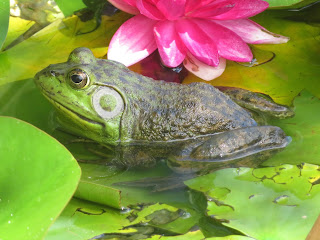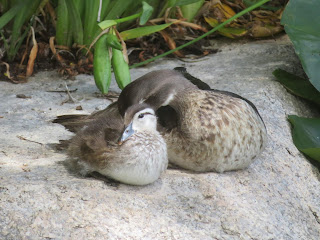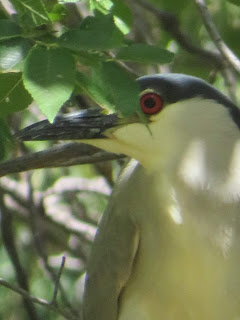Ecosystems are defined by how stable they are. They are also identified according to what the story you are telling is. Wetland habitats are often variable. They change according to tides, human activities, or the climate. The wildlife that lives here (including humans) often have to balance conflicting demands and either be flexible, or be ingenious.
The interior drain of Corrales is a fascinating and valuable wetland. They have the phenomena of "inundation". This chocolate colored water has very profound implications for the wildlife here. This water is from runoff from the soil surface and is full of many things including insect eggs, seeds, bacteria, oxygen, and clay. It is "energetic" water.A typical wetland from east of the Mississippi is more like tea. It is acidic, dark, cold, anoxic and clear. Nutrients are often locked away in the dark mud. The water in the clear ditch is usually filtered by at least 8 miles of cattails. This clarity allows sunlight to reach the ditch base. allowing extensive plant growth.
Siberian elm seedlings are prolific. The large leaves are very distinct from the "true" leaves that are just beginning to form and help get the growing process moving along quicker. This is important in the competitive quest for real estate.
amaranth seedlings are always eager to grow, but even more so this monsoon as the wet weather continues over the state. They prefer to grow along ditch banks but anywhere where moisture lingers will do.
Seeds have many tricks to get a head start over the competition. Mulberries are swallowed whole by coyotes (which are very fond of sugary treats). Because coyotes don't chew, the seeds come out whole in a pile of fertilizer, ready to grow. I have found grapes, apples, mulberries, beetles and tin foil in coyote scat. I entertain extreme doubts about their ferocity as savage killers of livestock and pets based on the evidence so far.
Now is the amphibian's time to shine. There are many tadpole species out there. This is one of my favorites, a desert tadpole of Spea multipicata; AKA New Mexico spadefoot.
There are ever weirder things out in the desert, like Triops longicaudatus. Look closely and you can see the three eyes and the long tail that give this crustacean it's name.
Wet weather and horses attract many types of flies. Some of these (like the biting deer flies) drive horses nuts with their persistence. The common house flies in this picture are harmless in the biting department and are more interested in producing the next generation.
Flies fill many niches in nature and this bright green one is a pollinator, but also a predator of pest insects. Condylostylus longicornis does not bite or transmit diseases. It can be very noticeable as it performs courtship dances on sunflower leaves now
Silverleaf nightshade has always bugged gardeners because it just will not go away. The bugs, however, are found in the blooms all summer long.
hummingbirds are not visiting the feeder in our yard much this year. Hopefully that is because there is plenty for them to find in the wild. They are usually totally preoccupied with chasing each other and other bird species away from their favorite perches. Little chunky Napoleons who survey their kingdoms.
This strange bird is a cormorant. There are quite a few around right now on the river. I suspect they are after small catfish that hide in the sediment heavy water
Wetlands are famous for the variety of birds they protect. However, most wetland preserves are managed for the benefit of duck hunters. This is a sandpiper in a more remote section of the Bosque preserve Rio Rancho sewage outflow.
While the water is cleaned before returning to the river, the euphemistically "reclaimed" water does contain problems, such as invasive plants like pond weeds. This one is a milfoil species. The clear, warm water allows many water plants to thrive in the nutrient rich soup from the outflow.
this ribbon weed is pretty rare in New Mexico waterways, but often found near outflows in urban areas. I'm not sure why its growing here. Maybe from hobbyist aquariums dumping old water. They do attract many duck species that graze on it.
The newly growing willows and cottonwoods growing in the Harvey Jones outflow already has many birds nearby that are excited to be colonizing new territory. This is a yellow breasted chat. This bird is usually hidden in thick brush, but the males need a exposed perch to advertise from.
Common snapping turtles have to risk everything to migrate to new locations for nesting. They often run afoul of pets, people and cars on their way. Not sure what happened to this one, but she was a old, mature female. The long, dragon like tail helps identify the species even though the head is gone.
The Rio grande is a very sediment rich river. Here you can see the "treated" effluent water from Rio Rancho flowing into the muddy river and the stark difference from the clear water. Water from dams or treated water is often sediment free. This encourages extensive plant growth, which comes with problems and benefits. The Harvey Jones wetlands has storm surface run-off and treated wastewater sections which both are completely different ecosystems. I'm willing to bet most people would not like the results of a chemical analysis of the water. Luckily no one is checking, other than Sandia pueblo and a few obscure government organizations. Hopefully, like this new delta, they can merge into a profitable whole for the benefit of the people, and the wildlife.






















































